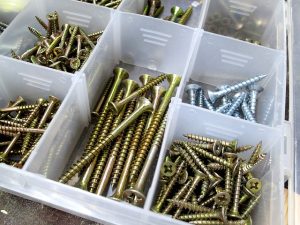
With the exception of “grub screws,” all screws have a head. It’s the top part of a screw that contains a recess for a tool bit. Screws are installed by placing a tool bit into the head’s recess and turning it. Although there are many types of screw heads, they can all be categorized as either countersunk or non-countersunk. Some screws have a countersunk head, whereas others have a non-countersunk head. What’s the difference between these two head styles exactly?
What Is a Countersunk Screw Head?
A countersunk screw head is characterized by its ability to rest flush with the surface into which it’s installed. The head essentially “sinks” into the workpiece’s surface. If you inspect a countersunk screw head, you’ll notice that it tapers towards the shank. This tapered design allows the head to dig into the workpiece’s surface.
Screws with a countersunk head are typically used in woodworking applications. When building furniture, manufacturers often use countersunk screws so that the heads don’t protrude. If the head protrudes out of a piece of furniture, such as a recliner, it will likely be uncomfortable to consumers to use. Therefore, wooden furniture is typically manufactured using countersunk screws.
What Is a Non-Countersunk Screw Head?
A non-countersunk screw head, on the other hand, protrudes out of the surface into which it’s installed. Rather than sinking into the workpiece’s surface, it protrudes out. Non-countersunk screw heads don’t taper towards the shank. Instead, they have a narrow shank that’s immediately proceeded by a wide head. Without tapering, non-countersunk screws can only be installed up to their head. When the head strikes the workpiece’s surface, the screw will stop. That’s as far as non-countersunk screws can be driven into a surface.
Non-countersunk screws are used in woodworking applications as well. They are oftentimes preferrable over countersunk screws because they place less stress on workpieces. The tapered area around countersunk screws is wider than their respective shank. As a result, installing countersunk screws into a workpiece can cause damage. Non-countersunk screws protect against such damage because they don’t have tapering. With non-countersunk screws, only the shank is driven into workpieces.
In Conclusion
Countersunk and non-countersunk refers to the style of a screw’s head. Countersunk is a head style that features tapering, thereby allowing it to be driven deeper into a workpiece’s surface. Non-countersunk is a head style without tapering, resulting in the protrusion of the head.
No tags for this post.